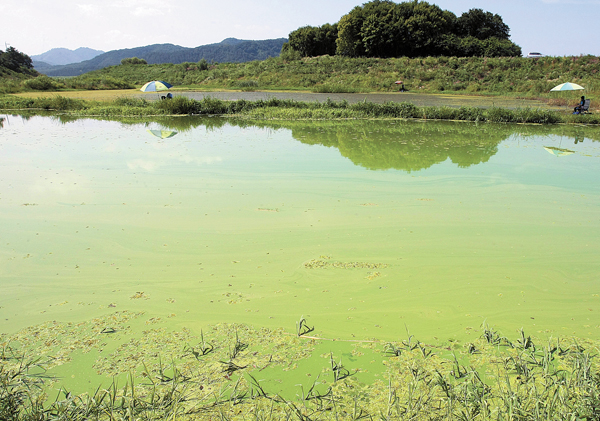Drought negatively affects river’s chemistry

Algal blooms spread along the Nakdong River yesterday between the Dalseong Weir in Daegu and the Hapcheon-Changnyeong Weir in South Gyeongsang, after the prolonged drought slowed the river’s current. By Gong Jeong-sik
In the scorching heat on Wednesday, eight employees of the Nakdong River Environment Research Center and the North Gyeongsang branch of Korea Environment Corporation boarded a water surface cleaning vessel to collect water samples from 10 points located 1 to 5 kilometers (0.6 to 3.1 miles) north of the Gangjeong-Goryeong Weir - a barrier smaller than a conventional dam - in Daegu.
The 30 samples from those spots will be used to conduct a detailed examination of the algal blooms, an assessment first introduced in February by the Ministry of Environment.
Upon reaching the last spot, a reporter from the JoongAng Ilbo who accompanied the researchers made a special request, asking them to measure the dissolved oxygen and pH levels on the water’s surface and at every subsequent meter below.
The pH level at the water’s surface stood at 8.9, a value that reached beyond the scale used for the evaluation of water quality in rivers and lakes, which is between pH 6 and 8.5. The alkalized water was assessed to be “very bad.”
Alkalinity is a measure of water’s capacity to neutralize acidic substances - acidic pollution from wastewater, for example. Water that is too alkaline can harm water quality as well as a river’s ecosystem, causing algal blooms or green tides, and changing the chemistry within a body of water.
Dissolved oxygen at the surface was 10.7 parts per million (ppm), but the level fell sharply to 0.3 ppm eight meters below - indicating that there was barely any oxygen. If the dissolved oxygen level stays lower than 2 ppm, the water quality is considered to be “very bad,” in accordance with evaluation standards, making it uninhabitable for fish and other creatures.
The law also stipulates that water evaluated as “very bad” cannot be used for drinking and industrial purposes, even after an advanced water treatment process.
“The water is lacking oxygen not only because of the algal bloom, but also because pollutants dumped into the riverbed by the sporadic rain these days are being decomposed,” said Cheon Se-eok, head of the Nakdong River Environment Research Center.
The situation wasn’t any better at other points. The pH levels of the surface water ranged between 8.3 and 8.9, exceeding 8.5 at five out of 10 points. Experts said that the alkalization was due to the algae using dissolved carbon dioxide for photosynthesis.
The level of dissolved oxygen in the water samples collected at six out of the 10 spots remained under 2 ppm. Analysts say a lack of oxygen in the bottom of rivers and lakes can produce toxic substances, such as ammonia and hydrogen sulfide, which can cause massive fish kill, and increase certain phosphates, aggravating algal blooms.
Environmental organizations, however, have pointed to the number of newly built weirs along Korea’s four major rivers, including the Nakdong River, claiming that they are obstructing the natural flow of the rivers and causing algal blooms.
“As the water stagnates longer, the impact on the Nakdong River’s ecosystem will be inevitable,” said Min Gyeong-seok, a professor of environmental engineering at Kyungpook National University. “Authorities should closely and constantly monitor the ecosystem of the river.”
BY KANG CHAN-SU [bongmoon@joongang.co.kr]










with the Korea JoongAng Daily
To write comments, please log in to one of the accounts.
Standards Board Policy (0/250자)